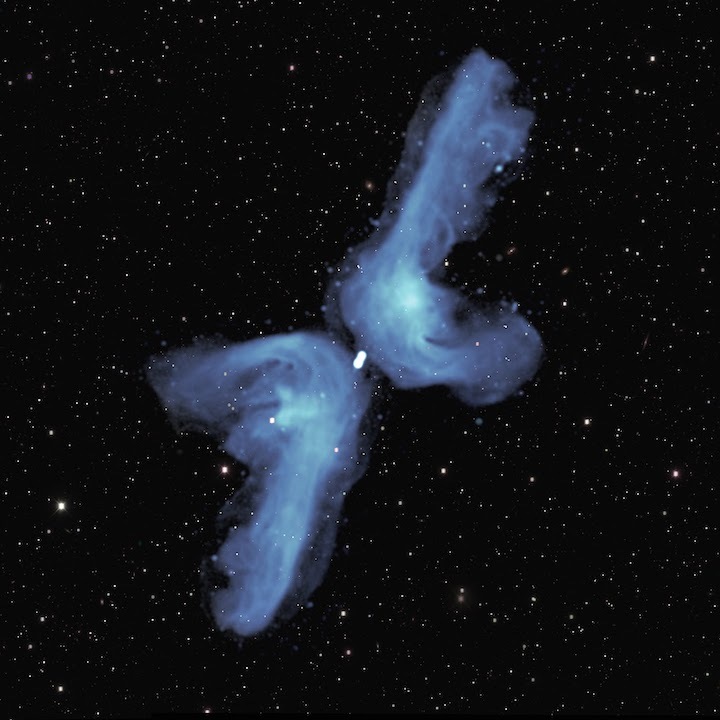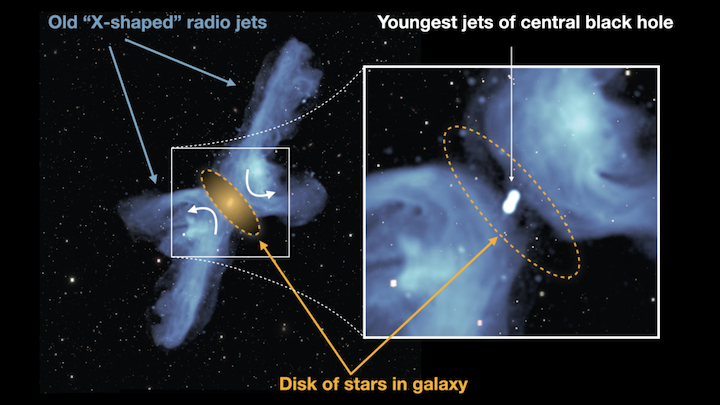10.05.2020
A team of astronomers from South Africa and the US have used the MeerKAT telescope to solve a longstanding puzzle in ‘X’-shaped radio galaxies.

The galaxy PKS 2014-55, located 800 million light years from Earth, is classified as ‘X-shaped’ because of its appearance in previous relatively blurry images. The detail provided in this radio image obtained with the MeerKAT telescope indicates that its shape is best described as a ‘double boomerang’. Two powerful jets of radio waves, indicated in blue color, each extend 2.5 million light years into space (comparable to the distance between the Milky Way and the Andromeda galaxy, our nearest major neighbour). Eventually, they are ‘turned back’ by the pressure of tenuous intergalactic gas. As they flow back towards the central galaxy, they are deflected by its relatively high gas pressure into the shorter, horizontal, arms of the boomerang. The background image shows visible light from myriad galaxies in the distant universe. Adapted from W Cotton et al, MNRAS (2020). Credit: NRAO/AUI/NSF; SARAO; DES.
Many galaxies far more active than the Milky Way have enormous twin jets of radio waves extending far into intergalactic space. Normally these go in opposite directions, coming from a massive black hole at the centre of the galaxy. However, a few are more complicated and appear to have four jets forming an ‘X’ on the sky.
Several possible explanations have been proposed to understand this phenomenon. These include changes in the direction of spin of the black hole at the centre of the galaxy, and associated jets, over millions of years; two black holes each associated with a pair of jets; and material falling back into the galaxy being deflected into different directions forming the other two arms of the ‘X’.
Exquisite new MeerKAT observations of one such galaxy, PKS 2014-55, strongly favour the latter explanation as they show material “turning the corner” as it flows back towards the host galaxy; the results have just been accepted for publication in the journal Monthly Notices of the Royal Astronomical Society.

Annotated image showing X-shaped giant radio galaxy PKS 2014-55, observed with the South African Radio Astronomy Observatory’s MeerKAT telescope, indicating the old X-shaped radio jets, the younger jets closer to the central black hole, and the region of influence dominated by the central galaxy’s stars and gas. The curved arrows denote the direction of the backflow that forms the horizontal components of the X. Credit: UP; NRAO/AUI/NSF; SARAO; DES.
This work was carried out by a team from the South African Radio Astronomy Observatory (SARAO), the (US) National Radio Astronomy Observatory (NRAO), the University of Pretoria, and Rhodes University.
Previous studies of these unusual galaxies lacked the high quality imaging provided by the recently completed MeerKAT telescope. This telescope array consists of 64 radio dishes located in the Karoo semi-desert in the Northern Cape province of South Africa. Computers combined the data from these antennas into a telescope 8 km in diameter, and provided images in the radio band of unprecedented quality for PKS 2014-55 which enabled solving the mystery of its shape.
Bernie Fanaroff, former director of the SKA South Africa project that built MeerKAT, and a co-author of the study, notes that “MeerKAT was designed to be the best of its kind in the world. It’s wonderful to see how its unique capabilities are contributing to resolving longstanding questions related to the evolution of galaxies.”
Lead author William Cotton of the NRAO says that “MeerKAT is one of a new generation of instruments whose power solves old puzzles even as it finds new ones – this galaxy shows features never seen before in this detail which are not fully understood.” Further research into these open questions is already underway.
THE SOUTH AFRICAN RADIO ASTRONOMY OBSERVATORY
The South African Radio Astronomy Observatory (SARAO), a facility of the National Research Foundation, is responsible for managing all radio astronomy initiatives and facilities in South Africa, including the MeerKAT radio telescope in the Karoo, and the geodesy and VLBI activities at the HartRAO facility. SARAO also coordinates the African Very Long Baseline Interferometry Network (AVN) for the eight SKA partner countries in Africa, as well as South Africa’s contribution to the infrastructure and engineering planning for the Square Kilometre Array radio telescope. To maximise the return on South Africa’s investment in radio astronomy, SARAO is managing programmes to create capacity in radio astronomy science and engineering research, and the technical capacity required to support site operations.
Quelle: SKA South Africa
